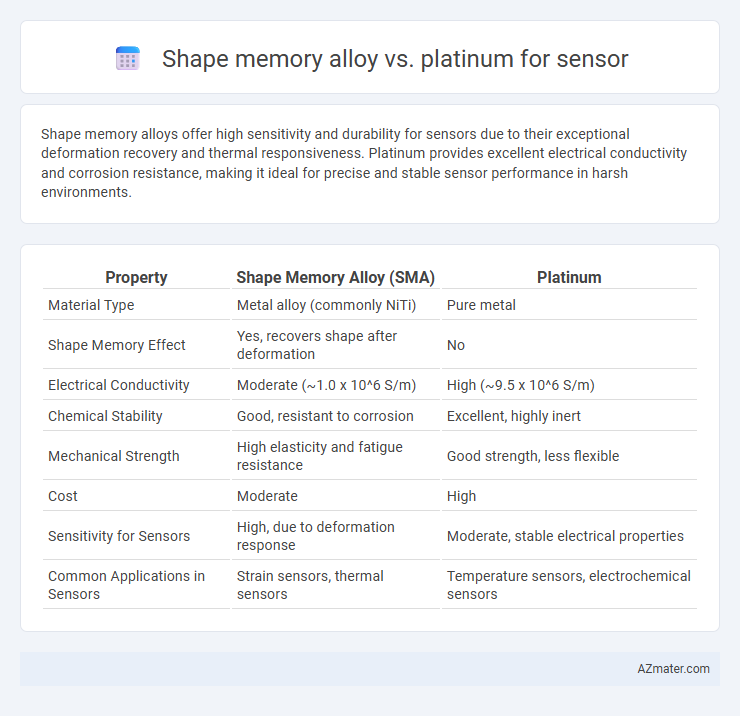Shape memory alloys offer high sensitivity and durability for sensors due to their exceptional deformation recovery and thermal responsiveness. Platinum provides excellent electrical conductivity and corrosion resistance, making it ideal for precise and stable sensor performance in harsh environments.
Table of Comparison
| Property | Shape Memory Alloy (SMA) | Platinum |
|---|---|---|
| Material Type | Metal alloy (commonly NiTi) | Pure metal |
| Shape Memory Effect | Yes, recovers shape after deformation | No |
| Electrical Conductivity | Moderate (~1.0 x 10^6 S/m) | High (~9.5 x 10^6 S/m) |
| Chemical Stability | Good, resistant to corrosion | Excellent, highly inert |
| Mechanical Strength | High elasticity and fatigue resistance | Good strength, less flexible |
| Cost | Moderate | High |
| Sensitivity for Sensors | High, due to deformation response | Moderate, stable electrical properties |
| Common Applications in Sensors | Strain sensors, thermal sensors | Temperature sensors, electrochemical sensors |
Introduction to Shape Memory Alloys and Platinum in Sensors
Shape memory alloys (SMAs) are advanced materials known for their ability to return to a pre-defined shape when exposed to specific temperature changes, making them ideal for precise actuation and sensing applications. Platinum, a noble metal with exceptional electrical conductivity and chemical stability, is widely used in sensors for detecting temperature, strain, and chemical changes due to its reliable performance under extreme conditions. Both SMAs and platinum offer unique advantages in sensor technology, with SMAs providing mechanical responsiveness and platinum ensuring accurate, stable signal transduction.
Material Properties: Shape Memory Alloy vs Platinum
Shape memory alloys (SMAs) exhibit unique thermomechanical properties such as high elasticity, shape recoverability, and excellent fatigue resistance, making them ideal for sensors requiring mechanical actuation and deformation sensing. Platinum offers superior electrical conductivity, chemical stability, and corrosion resistance, which ensures reliable and accurate sensor performance in harsh environments. The choice between SMA and platinum depends on application-specific demands for flexibility, durability, and electrical sensitivity in sensor design.
Sensitivity and Responsiveness Comparison
Shape memory alloys (SMAs) exhibit higher sensitivity to temperature and mechanical stress changes due to their unique phase transformation properties, enabling precise real-time sensing in dynamic environments. Platinum sensors provide exceptional stability and linearity, but their responsiveness is slower compared to SMAs because they rely on resistive changes rather than structural transformations. The rapid phase transitions in SMAs result in faster reaction times, making them preferable for applications demanding high responsiveness and adaptive sensitivity.
Temperature Stability and Performance
Shape memory alloys (SMAs) offer excellent temperature stability with a transformation range typically between -20degC and 80degC, making them ideal for sensors in moderate thermal environments. Platinum sensors outperform SMAs in high-temperature stability, maintaining accurate and consistent performance up to 1000degC due to platinum's inert chemical properties and stable electrical resistance. While SMAs provide fast response times and mechanical flexibility, platinum sensors deliver superior precision and longevity in extreme temperature applications, ensuring reliable measurement in industrial and scientific settings.
Durability and Fatigue Resistance
Shape memory alloys exhibit superior fatigue resistance with the ability to endure millions of deformation cycles without significant degradation, making them highly durable for sensor applications under dynamic conditions. Platinum, while chemically stable and corrosion-resistant, tends to suffer from brittle fracture and reduced fatigue life when subjected to repetitive mechanical stress. The exceptional durability and fatigue resistance of shape memory alloys enhance sensor reliability and lifespan in environments requiring frequent mechanical actuation.
Electrical Conductivity Differences
Shape memory alloys (SMAs) exhibit lower electrical conductivity compared to platinum, primarily due to their complex metal composition and phase transformation properties. Platinum's high electrical conductivity, approximately 9.43 x 10^6 S/m at room temperature, makes it ideal for precise sensor applications requiring stable electrical signals. SMAs such as nickel-titanium (NiTi) typically possess conductivity values much lower than platinum, affecting sensor sensitivity and response time in electrical measurements.
Corrosion and Chemical Resistance
Shape memory alloys exhibit superior corrosion resistance compared to platinum in harsh chemical environments, making them ideal for long-term sensor applications exposed to aggressive media. Platinum, while chemically inert and resistant to oxidation, can suffer from surface degradation in chloride-rich or sulfur-containing environments, potentially affecting sensor durability. The enhanced corrosion resistance of shape memory alloys contributes to stable sensor performance by minimizing material degradation and maintaining signal integrity over time.
Cost Efficiency Analysis
Shape memory alloys (SMAs) offer significant cost advantages over platinum in sensor applications due to their lower raw material costs and simpler fabrication processes. SMAs provide durability and reliable performance with minimal maintenance, reducing long-term operational expenses compared to the high material and processing costs of platinum sensors. The overall cost efficiency of SMAs makes them a favorable choice for large-scale, budget-sensitive sensor deployments where precise sensing capabilities are essential.
Suitability for Various Sensor Applications
Shape memory alloys (SMAs) offer exceptional strain sensing capabilities and self-recovery properties, making them highly suitable for flexible, wearable sensors and structural health monitoring applications. Platinum, with its stable electrical conductivity and excellent corrosion resistance, is ideal for high-precision temperature and chemical sensors operating in harsh environments. SMAs excel in applications requiring mechanical adaptability, while platinum is preferred for environments demanding long-term stability and accuracy.
Future Trends in Sensor Material Development
Shape memory alloys (SMAs) offer unique advantages in sensor applications due to their ability to undergo reversible phase transformations, enabling precise mechanical sensing and actuation, while platinum sensors excel in high-temperature stability and chemical inertness, crucial for harsh environments. Future trends in sensor material development emphasize hybrid systems that integrate SMAs' responsiveness with platinum's durability to enhance sensitivity, reliability, and multifunctionality. Advances in nanostructuring and additive manufacturing techniques aim to optimize these materials' microstructures, driving innovations in flexible, miniaturized, and wearable sensors with improved energy efficiency and environmental adaptability.

Infographic: Shape memory alloy vs Platinum for Sensor
 azmater.com
azmater.com